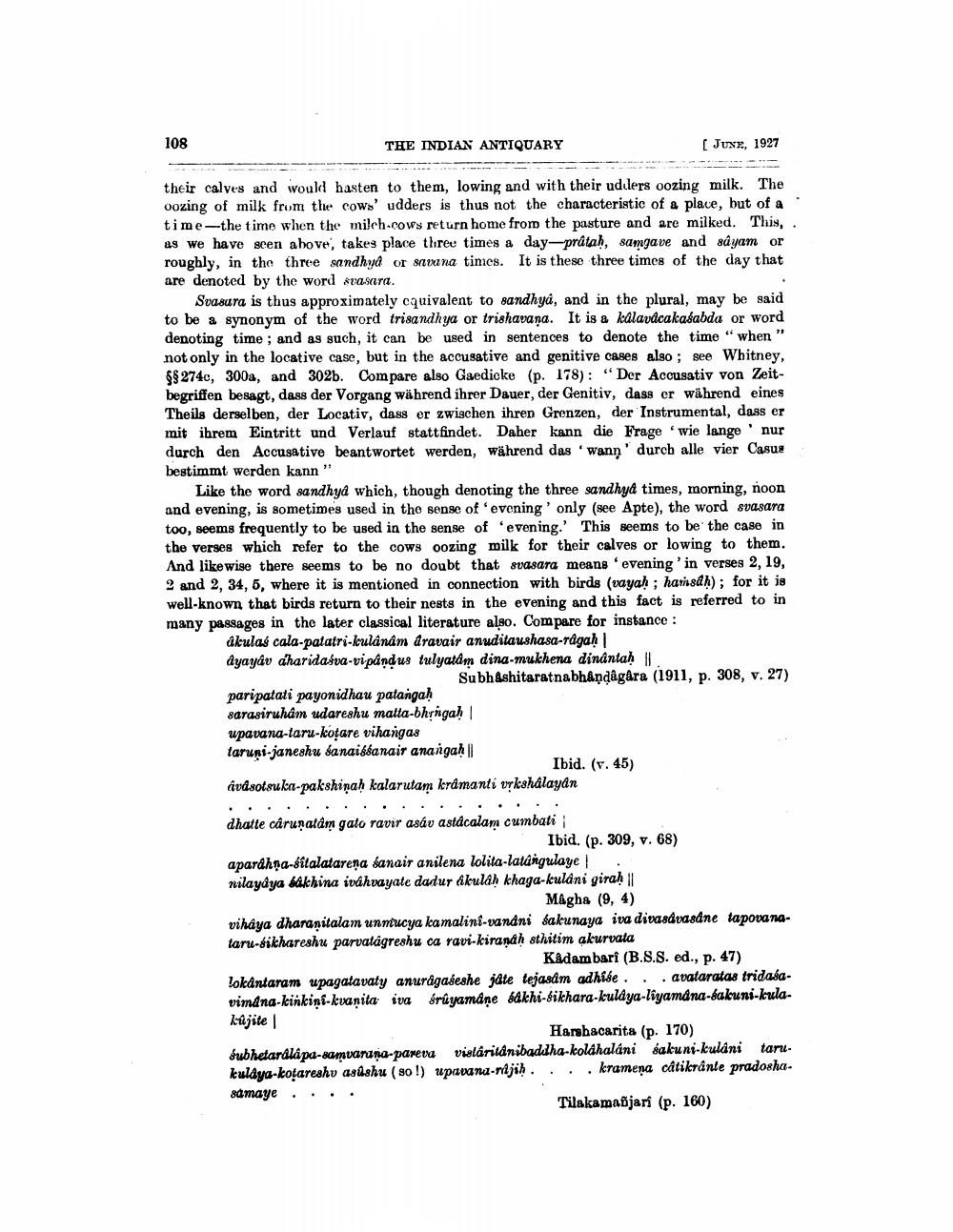________________
108
THE INDIAN ANTIQUARY
( Jux, 1927
their calves and would hasten to them, lowing and with their udders oozing milk. The oozing of milk from the cows' udders is thus not the characteristic of a place, but of a time--the time when the milch-cows return home from the pasture and are milked. This, . as we have seen above, takes place three times a day-prâtah, samgave and sayam or roughly, in the three sandhya or savana times. It is these three times of the day that are denoted by the word svasara.
Svasara is thus approximately equivalent to sandhya, and in the plural, may be said to be a synonym of the word trisandhya or trishavana. It is a kalavdcakasabda or word denoting time; and as such, it can be used in sentences to denote the times when" not only in the locative case, but in the accusative and genitive cases also ; see Whitney, $$ 274c, 300a, and 302b. Compare also Gaedicke (p. 178): "Der Accusativ von Zeitbegriffen besagt, dass der Vorgang während ihrer Dauer, der Genitiv, dass er während eines Theils derselben, der Locativ, dass er zwischen ihren Grenzen, der Instrumental, dass er mit ihrem Eintritt und Verlauf stattfindet. Daher kann die Frage wie lange nur durch den Accusative beantwortet werden, während das wann' durch alle vier Casus bestimmt werden kann"
Like the word sandhyd which, though denoting the three sandhyd times, morning, noon and evening, is sometimes used in the sense of evening' only (see Apte), the word svasara too, seems frequently to be used in the sense of evening. This seems to be the case in the verses which refer to the cows oozing milk for their calves or lowing to them. And likewise there seems to be no doubt that svasara means 'evening'in verses 2, 19, 2 and 2, 34, 5, where it is mentioned in connection with birds (vayah ; hamsdk); for it is well-known that birds return to their nests in the evening and this fact is referred to in many passages in the later classical literature also. Compare for instance :
Akulas cala-palatri-kulanám dravair anuditaushasa-rågah dyayav dharidaiva-vipând us tulyatám dina-mukhena dinantah !
Subhashitaratnabhåndâgâra (1911, p. 308, v. 27) paripatati payonidhau patangah sarasiruhám udareshu malta-bhrngah upavana-taru-kotare vihangas taruri-janeshu sanaissanair anangah
Ibid. (v.45) Avdsotsuka-pakshiņah kalarutam krámanti vrkshalaydn
dhatte cârunatam gato ravir asáv astácalam cumbatii
Ibid. (p. 309, v. 68) apardhņa-sitalatarena sanair anilena lolita-latangulaye . nilaydya lakhina ivdhvayate dadur akulah khaga-kulani girah ||
Magha (9, 4) vihaya dharanitalam unntucya kamalini-vandni fakunaya ira divasdraadne tapovanataru-bikhareshu parvatágreshu ca ravi-kirandh sthitim akurvata
Kadambari (B.S.S. ed., p. 47) lokántaram upagatavaty anurågaseshe jdte tejasdm adhibe... avataratas tridabavimdna-linkini-kvanita iva srüyamaņe bdkhi-tikhara-kuldya-liyamdna-bakuni-kulakujite
Harshacarita (p. 170) Subheardlapa-samvarana-parenu vislaritànibaddha-koldhalani sakuni-kulani tarukuldya-kogareshv asishu ( 80 !) upavana-nijih. .. krameņa càtikránle pradoshasamaye ....
Tilakamaõjari (p. 160)




